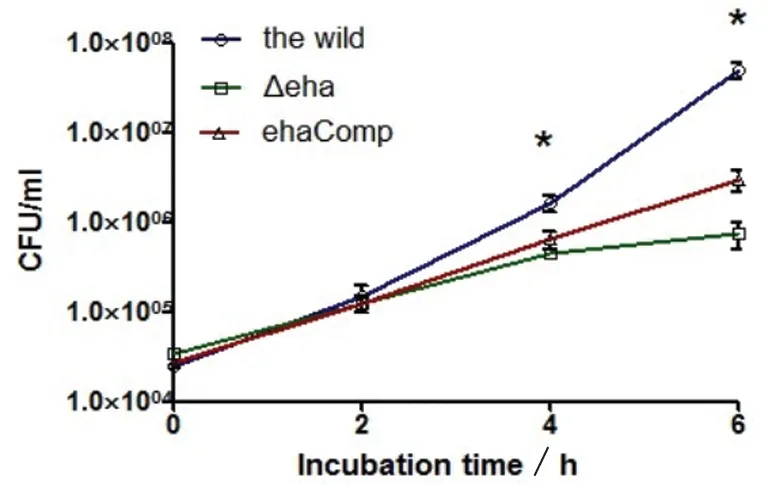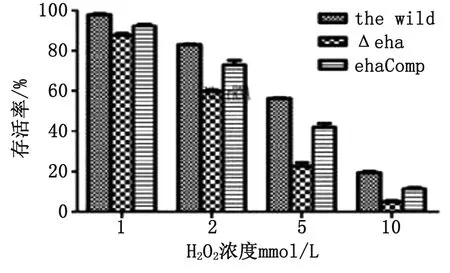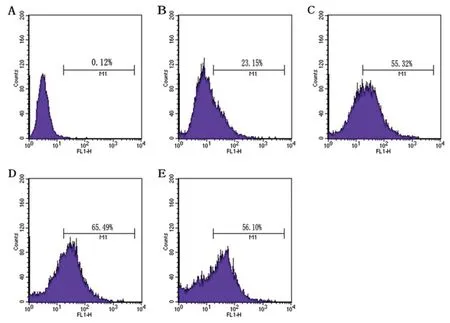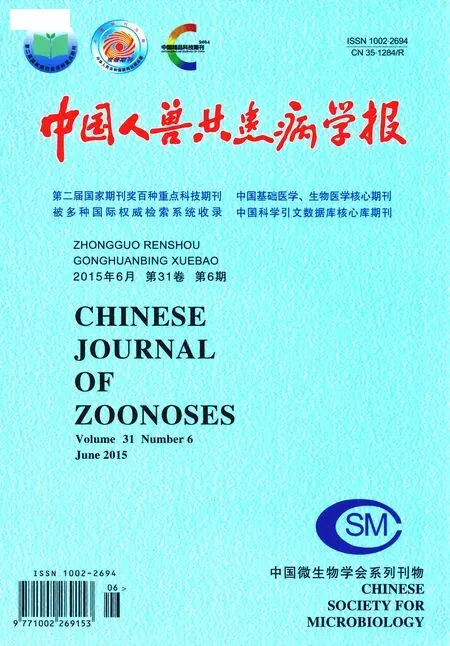eha基因调控迟缓爱德华菌抵抗巨噬细胞氧化杀菌作用
徐泽炎,李玉红,成 静,郑恩金,高大庆,盛安康,陆承平
·论 著·
eha基因调控迟缓爱德华菌抵抗巨噬细胞氧化杀菌作用
徐泽炎1,李玉红2,成 静1,郑恩金2,高大庆2,盛安康2,陆承平3
目的 迟缓爱德华菌(E.tarda)能够在巨噬细胞内生存和繁殖,必须抵抗细胞产生活性氧的杀菌作用。eha基因是该菌一个重要的转录调控基因,本研究探讨eha基因调控E.tarda抵抗巨噬细胞氧化杀菌的机制。方法 光镜观察野生株和缺失株分别感染RAW264.7巨噬细胞的过程,及菌落计数法测定细菌胞内存活数目;测定细菌在不同H2O2浓度中的存活率;流式法检测细菌感染巨噬细胞后产生活性氧的细胞比率;qRT-PCR测定细菌超氧化物歧化酶基因sodC和过氧化氢酶基因katB的转录水平。结果eha基因的缺失,使E.tarda在巨噬细胞内的繁殖速率明显下降(P<0.05),使该菌在不同H2O2浓度中的存活率显著降低(P<0.05),使该菌感染细胞组产生活性氧的细胞比率升高;qRT-PCR结果显示,eha基因的缺失使得该菌的超氧化物歧化酶基因sodC和过氧化氢酶基因katB转录水平下降。结论eha基因通过调控E.tarda菌分解H2O2相关基因的表达,从而影响该菌分解巨噬细胞中活性氧的能力和在胞内外的存活率。因此,eha基因调控了E.tarda菌抵抗巨噬细胞内氧化杀菌作用,有助于该菌在巨噬细胞内生存和繁殖。
eha基因;巨噬细胞;E.tarda;活性氧
迟缓爱德华菌(Edwardsiellatarda,简称E.tarda)属于肠杆菌科爱德华菌属,分布广泛,可感染鱼类、两栖类、爬行类、鸟类及哺乳类等。该菌能够引起多种鱼类感染,是水产养殖业的重要病原体[1]。该菌能够在巨噬细胞中生存和繁殖, 必须抵抗细胞产生活性氧(reactive oxygen species,ROS)的杀菌作用[2-3]。
高大庆等用鸟枪法在E.tarda中发现的一个溶血调控基因(Et haemolysin activator gene,简称eha),前期的研究表明Eha蛋白是E.tarda菌一个重要的转录调控因子[4-5]。本研究发现,和野生株相比,eha缺失株在巨噬细胞内繁殖速率和在不同浓度过氧化氢的存活率明显下降,并探讨eha基因调控E.tarda抵抗巨噬细胞氧化杀菌的机制。
1 材料与方法
1.1 材料
1.1.1 菌株和培养基 强毒株E.tarda菌ET-13由南京农业大学陆承平教授惠赠。ET-13的eha缺失株(Δeha)和Δeha互补株(ehaComp)由本室保存。细菌采用LB(Luria Broth)培养基来培养。
1.1.2 小鼠巨噬细胞 RAW264.7,巨噬细胞为上海兽医研究所王少辉博士惠赠。胎牛血清(FBS)、胰蛋白酶购自Hyclone公司;DMEM培养液购自Gibco公司。
1.2 方法
1.2.1 细菌胞内存活实验 以100∶1的感染复数MOI(multiplicity of infection) 将对数期细菌,加入单层细胞中,共孵育1 h后,PBS漂洗细胞3遍,再用含100 μg/mL庆大霉素的细胞培养液孵育1 h,换含10 μg/mL庆大霉素的细胞培养液继续培养2 h,4 h或6 h;在预定时间点,用PBS洗细胞3次,加入含1% Triton X-100的PBS裂解10 min,将裂解产物10倍系列稀释后,涂在LB琼脂平板上;37 ℃培养24 h,进行菌落记数(cfu/mL)。每次试验设3个平行组,取平均值,并重复3次;以培养时间为横坐标,CFU/mL为纵坐标,绘制细菌胞内细菌数目和时间的曲线。
1.2.2 光镜下观察 细菌感染细胞的方法同上,收集细胞;固定细胞,用姬母萨染液染色细胞和细菌。在油镜下观察,细菌被染成紫红色或紫蓝色,而细胞质则被染成浅红色。
1.2.3 体外应激实验 按参考文献[6]的方法检测各种浓度过氧化氢处理后细菌的存活率。
1.2.4 巨噬细胞产生活性氧的检测 以10∶1 MOI的对数期细菌感染RAW264.7细胞2 h后,将10 μmol/L DCFH-DA的DMEM培养液500 μL悬浮细胞,37 ℃培养20 min。用流式细胞仪(激发波长485 nm,发射波长530 nm) 检测细胞产生活性氧(reactive oxygen species, ROS)的细胞比率,设置未添加菌液细胞的孔为阴性对照。
1.2.5 qRT-PCR 按试剂盒说明书,提取细菌RNA, RNA逆转录成cDNA。再以cDNA为模版,用超氧化物歧化酶基因(superoxidedismutaseC,sodC)的引物(F-GACCGCCAGCCAAAGGTCCA,R-GCGAGTCGACTACGCGGACT)和过氧化氢酶基因(catalaseB,katB)的引物(F-ATGCGGGTCGGACGTGCCAG,R- TCCACGGGCCGTAGCGACA)分别扩增两基因,以扩增16SrRNA基因(F- TAGGTCGCTTAGGACATCTC,R- AGGGCCGGCTTGGCGACCGT)作为内标参照,定量检测各基因的转录水平。
1.2.6 统计学分析 细菌的存活率之间的比较采用t检验,以P<0.05为差异有统计学意义。
2 结 果
2.1 比较E.tarda野生株和eha缺失株在巨噬细胞内存活的差异 从图1中可以看出,用野生株和eha缺失株分别感染RAW264.7细胞1 h,高浓度庆大霉素杀胞外菌1 h,再低浓度庆大霉素继续培养,以抑制胞外菌的繁殖。用1% Triton X-100裂解细胞,释放胞内细菌,涂平板进行菌落计数(cfu/mL)。结果显示,胞内cfu/mL随培养时间呈上升趋势,这表明野生株和eha缺失株均可在巨噬细胞内存活并繁殖。和野生株相比,在继续培养4 h和6 h时,eha缺失株感染的细胞内细菌cfu/mL明显降低(P<0.05),表明eha基因对于E.tarda在巨噬细胞内的繁殖起重要的作用。互补株的变化趋势介于野生株和eha缺失株之间。

图1 比较E.tarda菌 ET-13野生株、eha缺失株和互补株在巨噬细胞内细菌数目的差异
2.2 光镜下观察野生株和eha缺失株在巨噬细胞内存活的差异 图2 结果显示,A和B是未感染细菌的RAW264.7细胞;C和D分别是RAW264.7细胞感染野生株和eha缺失株1 h,庆大霉素处理1 h后,可见胞内细菌;E和F分别是RAW264.7细胞感染野生株和eha缺失株1 h,庆大霉素处理1 h,再继续培养2 h后,可见细胞内细菌数量增多;G和H分别是RAW264.7细胞感染野生株和eha缺失株1 h,庆大霉素处理1 h,再继续培养6 h后,野生株在巨噬细胞内的数量大量增多,明显多于eha缺失株。

A and B :Uninfected RAW264.7 macrophages; C and D:RAW264.7 Infected with the wild and the Δeha for1 hours , and handled with gentamycin for 1 h; E and F:Incubated for 2 hours after C and D; G and H: Incubated for 6 hours after C and D. The arrows show the intracellular bacteria.
图2 光镜下观察野生株和eha缺失株在巨噬细胞内细菌数目的差异(×10 000)
Fig.2 Comparison of the differences of the survival rates of the wild and the Δeha of ET-13 within macrophages under light microscope(×10 00)
2.3 细菌经过氧化氢处理后的存活率 模拟细菌在巨噬细胞吞噬溶酶体氧化的环境,分别用不同浓度1 mmol/L、2 mmol/L、5 mmol/L、10 mmol/L的过氧化氢处理细菌30 min后,eha缺失株的存活率明显低于野生株(P<0.05),互补株的存活率介于缺失株和野生株之间,结果如图3所示。

图3 比较ET-13野生株、缺失株和互补株经过氧化氢处理后细菌存活率的差异
Fig.3 Comparison of the differences of survival rates of the wild,the Δeha and the ehaComp of ET-13
2.4 比较E.tarda野生株和eha缺失株刺激巨噬细胞产生活性氧的差异 收集细胞,检测细胞产生活性氧的细胞比率。流式结果如图4。加荧光探针未感染的细胞(图B)中产生活性氧的细胞比率为23.15%,高于未加荧光探针未感染的细胞组(图A),说明感染细菌后巨噬细胞产生活性氧的细胞比率相对未感染的细胞组高;eha缺失株感染细胞组(图D,65.49%)高于野生株组(图C,55.32%),互补株组(图E,56.10%)接近野生株组。
2.5 qRT-PCR显示eha基因对E.tarda和ROS相关基因的调控作用 由StepOnePlus Real-time PCR System Software得出数据,eha缺失株中超氧化物歧化酶基因sodC和过氧化氢酶基因katG的转录水平分别为野生株的0.1倍和0.42倍。因此,和野生株相比,Δeha缺失株中sodC 和katB的转录水平降低,结果提示E.tarda中eha基因对抗氧化相关的基因有正调控作用。
3 讨 论
E.tarda通过消化道粘膜和皮肤伤口感染宿主,被巨噬细胞等主要的固有免疫细胞吞噬,可在其中存活和繁殖,最后裂解细胞质膜,释放进入淋巴和血液,并感染全身[2]当巨噬细胞与E.tarda菌接触后,细菌表面的多种物质可激活巨噬细胞细胞膜的NADPH氧化酶,从而引起呼吸爆发,产生反应性氧中介物(reactive oxygen intermediate, ROI)或反应性氮中介物(reactive nitrogen intermediate,RNI)导致细菌损伤,如发生DNA突变、膜蛋白发生氧化变性失活等,从而杀死细菌。E.tarda菌产生各种酶分解巨噬细胞呼吸暴发产生的活性氧,逃避巨噬细胞的杀伤作用,达到在胞内存活和增殖的目的,最终导致疾病的发生[7]。E.tarda产生的过氧化氢酶(Kat B)和超氧化物歧化酶(SodB)可以帮助细菌将有毒害的氧化物降解为水和氧气[8]。

A: Uninfected and with no fluorescent probes; B: added by fluorescent probes and uninfected; C: added by fluorescent probes and infected with the wild; D: added by fluorescent probes and infected with the Δeha; E:added by fluorescent probes and infected with the ehaComp.
图4 比较 ET-13野生株、eha缺失株和互补株感染后巨噬细胞中产生活性氧细胞比率的差异
Fig.4 Comparison of the differences of the rate of cells produced ROS by the macrophages infected the wild,the Δeha and the ehaComp of ET-13
本研究表明E.tarda毒力株ET-13野生株和eha缺失株均能够在巨噬细胞内生存和繁殖,但eha缺失株在胞内繁殖速率明显降低。和野生株相比,其eha缺失株在不同浓度H2O2下生存能力降低,和缺失株产生过氧化氢酶和超氧化物歧化酶的产量减少有关,因此,eha基因可以调控E.tarda一些基因抵抗巨噬细胞氧化杀菌作用。
[1]Chen AP,Jiang YL,Qian D et al. Edwardsiellasis[J].China Fisheries,2011,7:49-50.(in Chinese) 陈爱平,江育林,钱冬,等. 迟缓爱德华氏菌病 [J].中国水产,2011,7:49-50.
[2]Leung KY, Siame BA, Tenkink BJ,et al.Edwardsiellatarda- Virulence mechanisms of an emerging gastroenteritis pathogen .Microbes Infect, 2012;14(1):26-34. DOI:10.1016/j.micinf. 2011.08.005.
[3]Ishibe K, Osatomi K, Hara K, et al. Comparison of the responses of peritoneal macrophages from Japanese flounder (Paralichthys olivaceus) against high virulent and low virulent strains ofEdwardsiellatarda[J]. Fish Shellfish Immunol,2008,24(2):243-51. DOI:10.1016/j.fsi.2007.11.001.
[4]Gao DQ, Kan B, Lu CP,et al. Primary Analysis and Sequencing the Hemolytic Relative Gene ofEdwardsiellatarda[J].J Genetics Genomics. 2001,25(12):1162-1167.(in Chinese) 高大庆,阚飙,陆承平,等.迟缓爱德华菌溶血相关基因的测序和初步的功能分析[J].遗传学报,2001,25(12):1162-1167.
[5]Gao DQ, Cheng J, Zheng EJ,et al. Eha, a transcriptional regulator of hemolytic activity ofEdwardsiellatarda[J]. FEMS Microbiol Lett 2014,353(2),132-140. DOI:10. 1111/1574 -6968.12420.
[6]Pan HJ, Hao B, Li J,et al, Impact of Cpx on the virulence ofEdwardsiellatarda[J]. Marine Sci, 2013,37(2):17-21. (in Chinese) 潘海建,郝斌,李杰,等. Cpx 对迟缓爱德华氏菌毒力的影响[J].海洋科学,2013,37(2):17-21.
[7]Srinivasa Rao PS, Lim TM, Leung KY. Opsonized virulentEdwardsiellatardastrains are able to adhere to and survive and replicate within fish phagocytes but fail to stimulate reactive oxygen intermediates[J]. Infect Immun,2001,69(9):5689-5697.DOI:10.1128/IAI.69.9.5697.2001.
[8]Cheng S, Zhang M, Sun L. The iron-cofactored superoxide dismutase ofEdwardsiellatardainhibits macrophage-mediated innate immune response [J]. Fish Shellfish Immunol,2010,29(6):972-978. DOI:10.1016/j.fsi. 2010.08.004.
Gao Da-qing,Email: dgao2@yahoo.com
ehagene is required forEdwardsiellatardaoxidative stress resistance in macrophage
XU Ze-yan1,LI Yu-hong2,CHENG Jing1,ZHENG En-jin2,GAO Da-qing2,SHENG An-kang2,LU Cheng-ping3
(1.SchoolofMedicine,JiangsuUniversity,Zhenjiang212000,China; 2.SchoolofMedicine,SoutheastUniversity,Nanjing210009,China; 3.CollegeofVeterinaryMedicine,NanjingAgriculturalUniversity,Nanjing210095,China)
AsEdwardsiellatarda(E.tarda)can survive and replicate in macrophages, it must resist against reactive oxygen species (ROS) produced by the cells. The haemolysin activator gene (eha) is an important transcriptive regulating gene.Our researches studied the mechanism for theehagene how to regulateE.tardato resist oxidation stress in macrophages. After the bacteria have infected RAW264.7 macrophages, bacterial colonies were counted on LB plates. The results of the above experiment and the observation under optical microscope indicated that both the wild and the Δehastrains can survive and multiply within macrophages, and the reproductive rate of the Δehawithin macrophages decreased obviously than that of the wild. The survival rate of the Δehain H2O2was less than that of the wild. After the level of ROS from macrophages infected with bacteria were detected by flow cytometry(FCM), the ROS from the macrophages infected with the Δeha(65.49%) was more than that of the wild (55.32%). The qRT-PCR results showed further that the mutation of theehagene regulated down the expressions of catalase and superoxide dismutase genes inE.tarda. Therefore, the results indicated thatehagene has affected bacterial ability of decomposing ROS in macrophages and survival ability in H2O2,as the gene may control the expressions of catalase and superoxide dismutase genes inE.tarda.
ehagene;macrophage;Edwardsiellatarda; ROS
高大庆,Email:dgao2@yahoo.com
1.江苏大学医学院,镇江 212000; 2.东南大学医学院,南京 210009; 3.南京农业大学动物医学院,南京 210095
Supported by the Doctor Inovation Fund of Jiangsu Province(No. CX10B-283z), and the Natural Science Foundation of Jiangsu(No.SBK2015022394)
10.3969/cjz.j.issn.1002-2694.2015.06.001
R378.2
A
1002-2694(2015)06-0497-04
2014-06-11;
2014-11-09
江苏省博士研究生创新课题基金(No.CX10B-283z)资助和江苏省自然科学基金联合资助(No.SBK2015022394)

